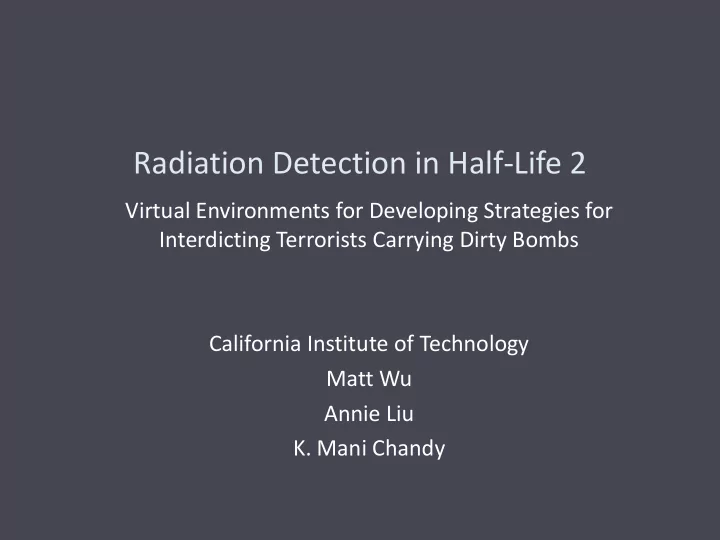

Radiation Detection in Half ‐ Life 2 Virtual Environments for Developing Strategies for Interdicting Terrorists Carrying Dirty Bombs California Institute of Technology Matt Wu Annie Liu K. Mani Chandy
Stop terrorists from exploding radiological weapons over critical spaces
Stop terrorists with dirty bombs in backpacks What if this is a dirty bomb? Courtesy of thingsyoushoulddo.com
Real Scenarios � Terrorists trying to smuggle radioactive material into the United States � Police in Slovakia and Hungry arrested three men for trying to sell “dangerous” radioactive material ( CNN.com, November 29 2007 ) � Radiation detectors are triggered much too frequently by false positive at sea ports � U.S. is greatly increasing its monitoring of foreign cargo for radioactive response ( LA Times, November 25 2007 )
Challenges � How do we interdict a terrorist before he sets off a dirty bomb? � How should the radiation detectors be deployed? � What’s the optimal strategy for a team of mobile sensors to detect one or more moving radiation sources? � Can stationary sensors on traffic IPRL handheld detectors developed lights or lampposts help? at the Caltech � How can false positives be limited? M. Chandy, C. Pilotto, R. McLean Network Sensing Systems For Detecting People Carrying Dirty Bombs
Related Works � Studies of sensor network (M. Chandy, C. Pilotto, R. McLean) � Estimating the position of a static source within a bounded area Probability of a bayesian update without noise in the first 10 seconds � Cell phone sensors detect radiation to thwart nuclear terrorism (E. Fischbach, J. Jenkins, Purdue University) � Sensor network constructed using the global positioning locators built ‐ in in cell phones � Can detect weak source as far as 15 feet away Purdue University News, http://news.uns.purdue.edu/x/2008a/080122FischbachNuclear.html
Defense Against Creative Enemies � Our enemies may not behave the way we think they will � Traditional computer simulation doesn’t give much insights � To deal with creative enemies we develop systems with teams of terrorists and security personnel playing against each other � Our solution: A multi ‐ player virtual gaming environment!
Requirements � Realistic representation of the environment � Must be able to mimic correct physics in real world � Airports, sea ports, Rose Bowl, …etc � Representations of radiation sources, agents, and robots � We assume that terrorists are on foot with lightly shielded radiation source � Global virtual environment � Enable collaboration of many agencies
Platforms Studied � Second Life � Popular online virtual community � Easy to access and collaborate within � Most realistic representation of the real world � Drawback: Limited API Simulating photon hit probability in Second Life
Platforms (cont.) � Player/Stage � Multi ‐ robot controller server and environment emulator � 2D bitmapped environment � Most realistic choice to encode strategies for autonomous agents � Drawbacks: No means of user inputs Autonomous agents maneuvering in Player/Stage
Platforms (cont.) � Half ‐ Life 2 � The source code is available for each copy of the Half ‐ Life 2 game � Optimized game, physics, and graphic engines that are capable of handling large amount of calculations required for photon simulation � Well ‐ documented API and plenty of community support � Abundant resources available � Best option of all three Autonomous agents having identified the radiation source and taking photographs of the suspect.
Accomplishments � Photon simulation and detection � Photons are generate and detected in a Poisson manner � Absorption of photons � Photon intensity decreases exponentially when encountering objects � Background radiation � Different materials emit different levels of radiation, which is determined by : ∑ m p m .g m .A � Heat map generation � Mobile sensors
Radiation Model Sensor intensity: Joint radiation probability • • μ ⋅ θ distribution given intensity A cos( ) λ = π 2 d 4 Probability of detecting at least • one photons in t seconds = 1 − − λ t P ( t ) e 1 λ Graphics explanation for ~ d • 2
Various Detector Models Spherical Unshielded flat panel Shielded flat panel Intensity (I) ~ 1/d^2 I ~ |cos(Ø)/d^2| I ~ max(cos(Ø)/d^2,0) Heat map generated given stationary detectors of different models
Future Directions � Rapid interdiction � Optimal mobile agent algorithm � Photon detection without assumption of source intensity � Implement sensors that can detect different signatures of radiation isotope � Algorithms for detecting mobile radiation sources
Acknowledgements � We thank the following people � Dr. Mani Chandy � Concetta Pilotto � Dr. Ryan McLean � Dr. Joel Burdick � Jeremy Ma � Timothy Chung � This research is supported by the California Institute of Technology Information Science and Technology Center and AFOSR0 MURI FA9550 ‐ 06 ‐ 1 ‐ 033 .
Recommend
More recommend